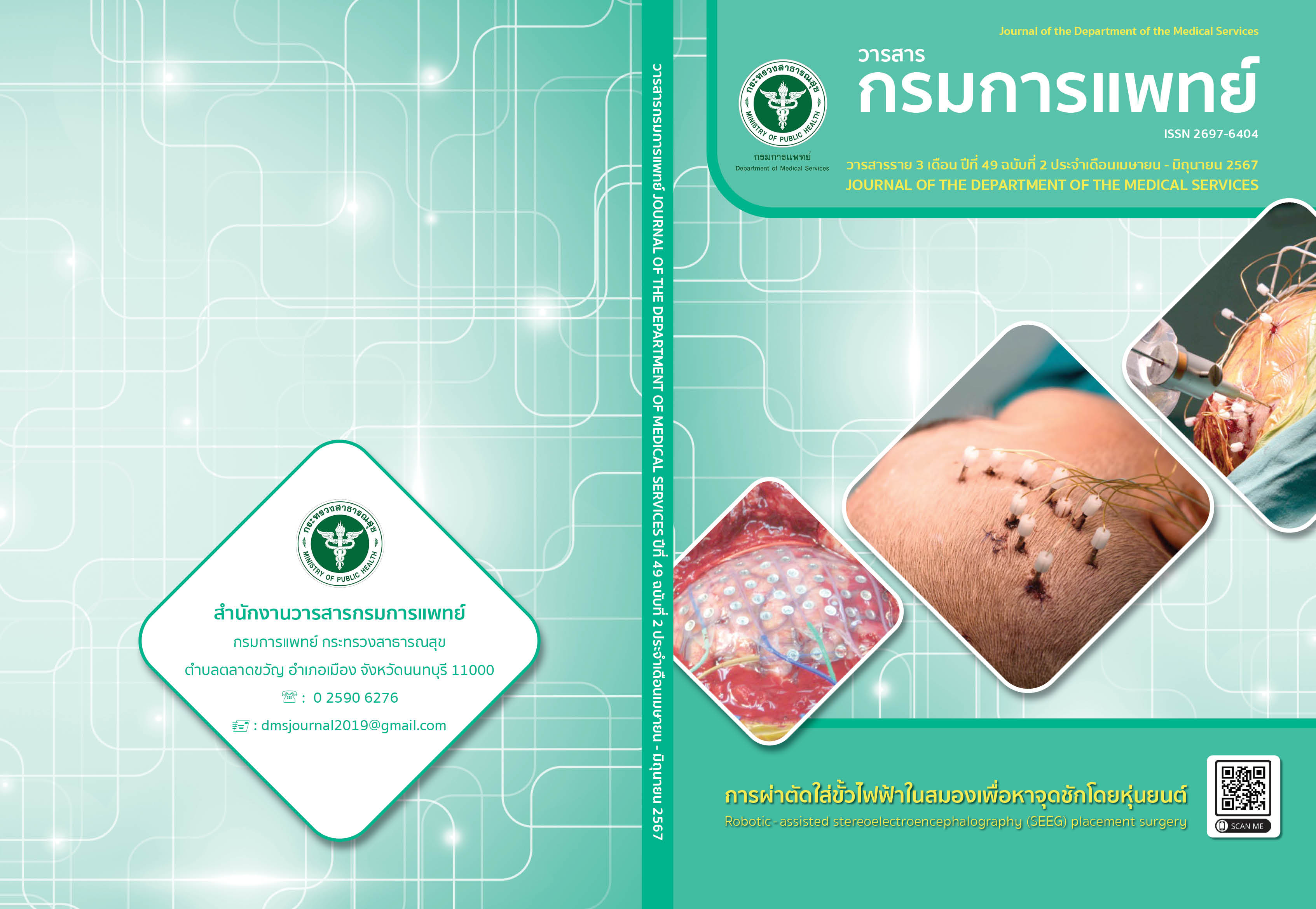The Evaluation of Relationship between Speech and Velopharyngeal Anatomy in 6 to 12 Year - old Children with Operated Cleft Palate Patients
Keywords:
Cleft palate, Velopharyngeal anatomy, Lateral cephalometric radiograph, Hypernasality, HyponasalityAbstract
Background: Velopharyngeal insufficiency is a cause of articulation disorders in patient with cleft palate. Objectives: (1) To study velopharyngeal anatomy (2) To evaluate the articulation in cleft palate compared to non - cleft palate patients (3) To study relationship between velopharyngeal anatomy and articulation. Method: The subjects were 23 cleft palate (mean age 8.93.5 years) and 52 non - cleft palate patients (mean age 9.3
0.7 years). Lateral cephalometric radiographs were traced for measured length of soft palate, velar thickness, DPS, depth of pharyngeal space and angle of soft palate. The passage “Ma Nee” was used for hyponasality test and the passage “Tuk Tuk” was used for hypernasality test. Result: The result showed significant difference between cleft and non - cleft palate patients in length of soft palate, depth of pharyngeal space, angle of soft palate, hypernasality and hyponasality (p < .05). A negative correlation between velopharyngeal anatomy (length of soft palate and angle of soft palate) and hypernasality was shown (p < .05). No correlation between velopharyngeal anatomy and hyponasality was found. Conclusion: (1) Lesser length of the soft palate, depth of pharyngeal space and angle of the palate were found in cleft compared to non - cleft patients. (2) A significant difference in hypernasality and hyponasality showed between two groups. (3) The length of the soft palate and angle of the palate negatively correlated with hypernasality.
References
Panamonta V, Pradubwong S, Panamonta M, Chowchuen B. Global birth prevalence of orofacial clefts: A systematic review. J Med Assoc Thai 2015;98(Suppl 7):S11 - 21.
Chowchuen B, Thanaviratananich S, Chichareon V, Kamolnate A, Uewichitrapochana C, Godfrey K. A multisite study of oral clefts and associated abnormalities in Thailand: The epidemiologic data. Plast Reconstr Surg Glob Open 2016;3(12):e583.
Sununliganon L, Chetpakdeechit W. Guideline for multidisciplinary team approach in cleft lip and palate patient. TUHJ 2017;2(2):15 - 27.
Kudo K, Takagi R, Kodama Y, Terao E, Asahito T, Saito I. Evaluation of speech and morphological changes after maxillary advancement for patients with velopharyngeal insufficiency due to repaired cleft palate using a nasometer and lateral cephalogram. J Oral Maxillofac Surg Med Pathol 2014;26(1):22 - 7.
Kummer AW. Speech therapy for errors secondary to cleft palate and velopharyngeal dysfunction. In: Seminars in speech and language. New York: Thieme Medical Publishers; 2011. p. 191 - 98.
Bearn DR, Sandy JR, Shaw WC. Cephalometric soft tissue profile in unilateral cleft lip and palate patients. Eur J Orthod 2002;24(3):277 - 84.
Liu R, Lu D, Wamalwa P, Li C, Hu H, Zou S. Craniofacial morphology characteristics of operated unilateral complete cleft lip and palate patients in mixed dentition. Oral Surg Oral Med Oral Pathol Oral Radiol Endod 2011;112(6):e16 - 25.
Romanini RCS, Vedovello S, Raitz R, Silva MBF, Junqueira JLC, Oliveira LB. Craniofacial features of operated unilateral complete cleft lip and palate children: a case control study. RGO- Revista Gaúcha de Odontologia 2014;62(4):383 - 8.
Scarmagnani RH, Barbosa DA, Fukushiro AP, Salgado MH, Trindade IE, Yamashita RP. Relationship between velopharyngeal closure, hypernasality, nasal air emission and nasal rustle in subjects with repaired cleft palate. Codas 2015;27(3):267 - 72.
Hulley SB, Cummings SR, Browner WS, Grady D, Newman TB. Designing clinical research : an epidemiologic approach. 4th ed. Philadelphia, PA: Lippincott Williams & Wilkins; 2013. p.79.
Pracharitpukdee N, Manochiopini S, Lertsarunyapong S, Sutantawibon P. The Thai nasality test for cleft palate patients. Chula Med J 1999 43(10):711 - 21.
Prathanee B. Speech and language problems in Cleft Palate. Srinagarind Med J 2001;16(1):8 - 26.
Wyatt R, Sell D, Russell J, Harding A, Harland K, Albery L. Cleft palate speech dissected: a review of current knowledge and analysis. Br J Plast Surg 1996;49(3):143 - 9.
Jakkabat J, Pimkhaokhaokham A, Tudsri S, Pracharitpukdee N. Speech evaluation in a group of Thai cleft lip and palate patients after surgical closure of oronasal fistula. CU Dent J 2009;32(2):143 - 56.
Impieri D, Tønseth KA, Hide Ø, Brinck EL, Høgevold HE, Filip C. Impact of orthognathic surgery on velopharyngeal function by evaluating speech and cephalometric radiographs. J Plast Reconstr Aesthet Surg 2018;71(12):1786 - 95.
McComb RW, Marrinan EM, Nuss RC, Labrie RA, Mulliken JB, Padwa BL. Predictors of velopharyngeal insufficiency after Le Fort I maxillary advancement in patients with cleft palate. J Oral Maxillofac Surg 2011;69(8):2226 - 32.
Downloads
Published
How to Cite
Issue
Section
License
Copyright (c) 2024 Department of Medical Services, Ministry of Public Health

This work is licensed under a Creative Commons Attribution-NonCommercial-NoDerivatives 4.0 International License.
บทความที่ได้รับการตีพิมพ์เป็นลิขสิทธิ์ของกรมการแพทย์ กระทรวงสาธารณสุข
ข้อความและข้อคิดเห็นต่างๆ เป็นของผู้เขียนบทความ ไม่ใช่ความเห็นของกองบรรณาธิการหรือของวารสารกรมการแพทย์



